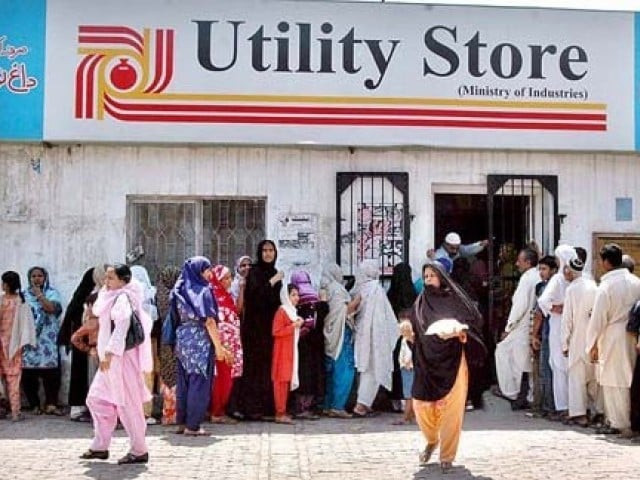ISLAMABAD:
The government on Wednesday reaffirmed its decision to close the lossmaking Utility Stores Corporation from the end of this month and constituted a panel to consider giving a golden handshake to 11,421 employees that may cost it over Rs29 billion.
It was not clear whether the government would give the severance package to all 11,421 employees or limit it to regular 5,217 employees. The discussions took place during a meeting of a committee constituted by the Prime Minister to oversee the closure and privatization of the Utility Stores Corporation (USC).
Finance Minister Muhammad Aurangzeb chaired the meeting, which was attended by other cabinet members.
The committee has been tasked with ensuring a smooth and transparent closure process, formulating a suitable VSS for USC employees, and recommending a structured timeline for privatisation, said the Ministry of Finance.
The finance ministry said that the committee reviewed the progress made in the light of the tasks assigned to it and held detailed deliberations on the way forward.
“It was reaffirmed that, in accordance with the government’s directives, all operations of USC will be closed by July 31, 2025,” according to the Ministry of Finance. The committee discussed at length the formulation of a fair and financially viable Voluntary Separation Scheme (VSS) for the USC employees, it added.
Trading entities like USC struggled with high liabilities, ineffective subsidy utilisation, and operational inefficiencies, according to the SOEs performance report that the Ministry of Finance released last week. It added that dependence on delayed government subsidies creates cash flow crisis, while poor inventory management worsens fiscal risks
The Finance Ministry report stated that the USC lost Rs6.1 billion at the operating level during July-December period of last fiscal year and it was riddled with finance costs, adding to the burden due to compounding operational losses.
The USC model is subsidy-driven rather than market and cumulative losses stood at Rs15.9 billion as of December last year, according to the Finance Ministry. It added that the balance sheet revealed a weak equity of just Rs1.8 billion, heavily overshadowed by current liabilities of Rs50.7 billion, reflecting solvency risks and negative working capital.
According to the official documents, there were a total 11,421 employees of the USC, including 5,217 regular employees. The total cost of the golden handshake is estimated at Rs29.2 billion, including Rs22.8 billion for the regular employees. However, these figures are not final and the cost of the severance package will be determined by another committee.
The details showed that the regular employees having over 20 years association with the USC would get two running basic pays of the completed years while those having less than 20 years of experience will get either three running basic pay of completed years or 125% of the basic pay of the remaining months, whichever is higher.
The regular employees will also get terminal dues and house rents.
There are 3,319 contractual employees who are proposed to receive two running basic pay of completed years as compensation, which will cost Rs3.5 billion. Another 2,885 are the daily wagers who are proposed to be given two salaries of the completed years that will cost Rs2.9 billion.
The entity has 21 properties and it also faces a major issue of non-payments of promised subsidies of over Rs50 billion by the Ministry of Finance.
The Finance Ministry handout stated that during the course of the meeting, the members examined various dimensions of the proposed VSS, including its projected size, potential fiscal impact, and legal and operational implications associated with its structure and rollout. The Committee recommended that the Privatization Commission be consulted regarding the optimal structuring and feasibility of privatization or alternatively asset sales linked with the USC operations.
To facilitate a comprehensive analysis, the Chair constituted a sub-committee headed by the Secretary Establishment Division, stated the ministry.
The committee will include representatives from the Finance Division and the Industries & Production Division to examine the legal and operational aspects, contours, size, and structure of the proposed VSS and submit its report to the main Committee by the end of the week.
This will enable the Committee to consolidate its findings and finalize its report and recommendations to be submitted to the Prime Minister in line with the Terms of Reference, said the Ministry of Finance.
The SOEs report stated that USC’s heavy reliance on government subsidies and declining sales highlighted systemic inefficiencies. The USC reflects a structurally weak and inefficient business model that is unsustainable without continuous government subsidies.
The report showed that the company’s sales sharply dropped by more than 50% compared to the same period last year — showing the company’s inability to retain market share or operate competitively. However, one of the reasons for drop in sales was the government’s decision to wind up the entity.
The report underlined that without structural reform, including privatization, supply chain digitization, direct beneficiary targeting (DBT) of subsidies, and converting to a lean wholesale model, USC will continue draining fiscal resources with no viable path to self-sustainability.

